Case Study Analysis: Poweo's Challenges in French Electricity Market
VerifiedAdded on 2019/12/03
|24
|6701
|32
Case Study
AI Summary
This case study analyzes Poweo, a company operating in the French electricity market, focusing on the challenges it faced due to unfavorable economic conditions, regulatory hurdles, and intense competition from established players like EDF and GDF. The study examines the impact of market liberalization, the lack of switching costs for end-users, and the company's financial performance, including a significant net loss. The report provides a detailed overview of the French electricity market, including its structure, government regulations, and the influence of nuclear power. Various management tools, including the Heckscher-Ohlin model, Hofstede's model, Mintzberg's management roles, McKinsey 7's model, Porter's Five Forces, PEST and SWOT analyses, benchmarking, and ratio analysis, are applied to identify problems and propose solutions. The case explores Poweo's strategic options, including investment in a new power plant, cost-cutting measures, and adapting to market reforms. The analysis also considers the historical context of the French electricity market, including the role of EDF and government policies. The study concludes with recommendations to improve Poweo's financial position and navigate the competitive landscape, along with limitations and suggestions for future research.
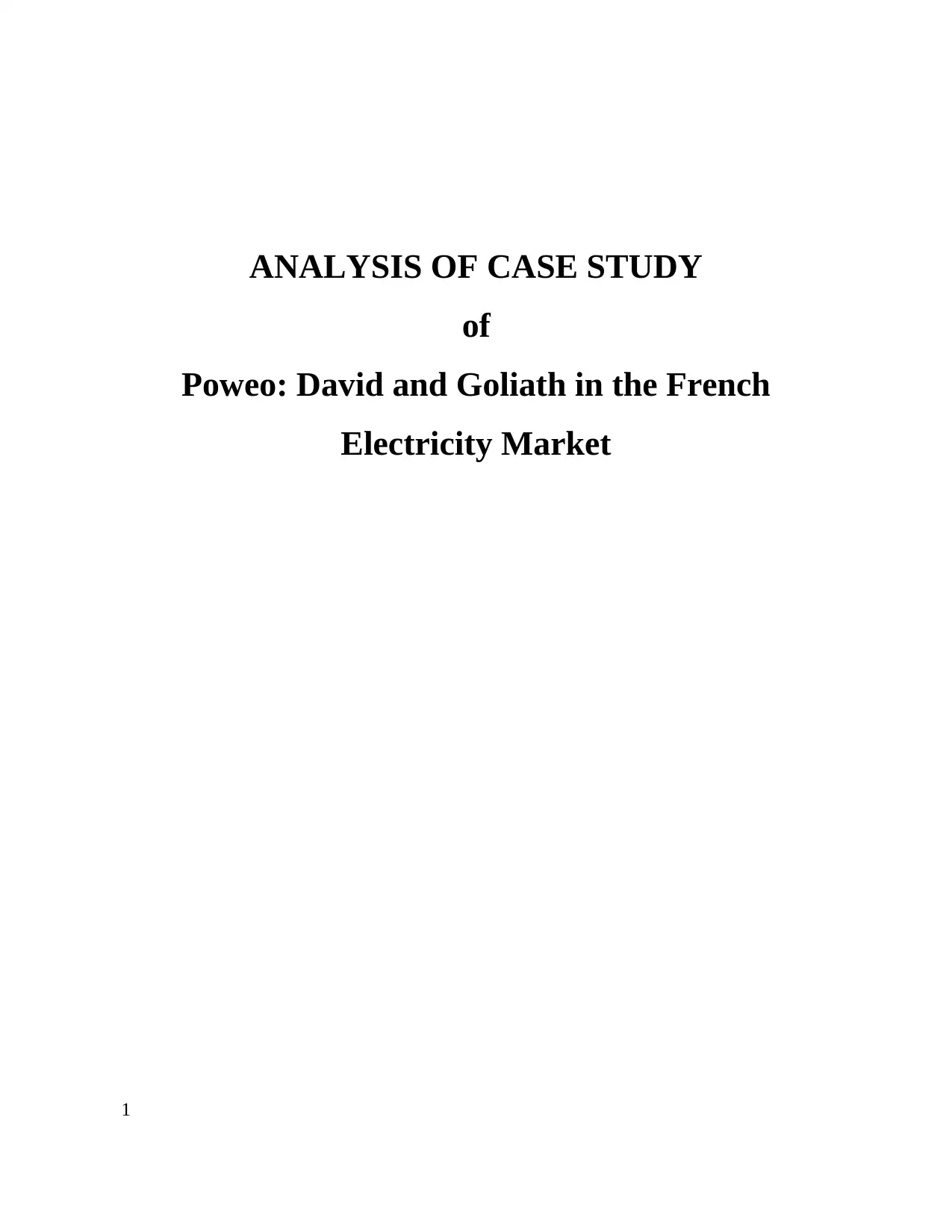
ANALYSIS OF CASE STUDY
of
Poweo: David and Goliath in the French
Electricity Market
1
of
Poweo: David and Goliath in the French
Electricity Market
1
Paraphrase This Document
Need a fresh take? Get an instant paraphrase of this document with our AI Paraphraser
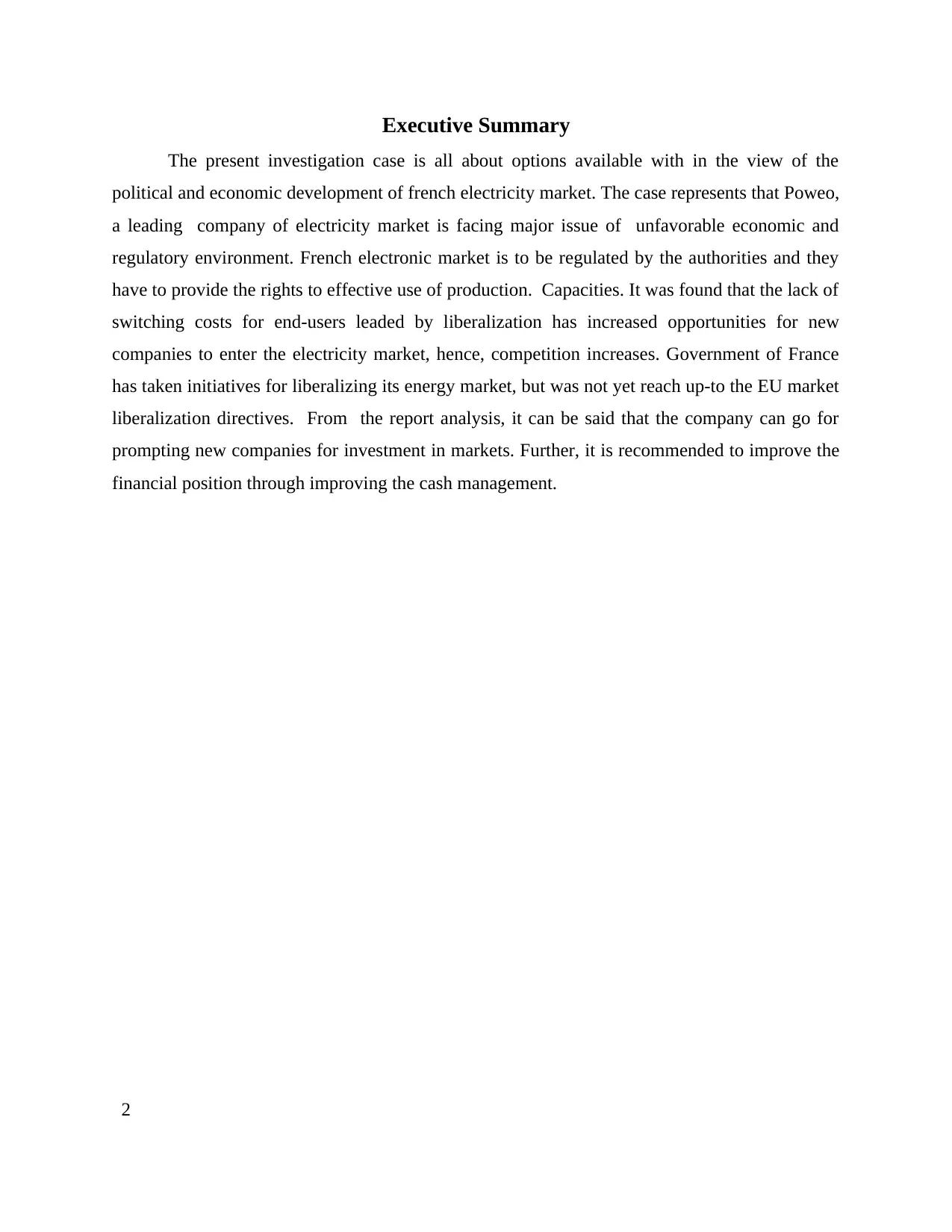
Executive Summary
The present investigation case is all about options available with in the view of the
political and economic development of french electricity market. The case represents that Poweo,
a leading company of electricity market is facing major issue of unfavorable economic and
regulatory environment. French electronic market is to be regulated by the authorities and they
have to provide the rights to effective use of production. Capacities. It was found that the lack of
switching costs for end-users leaded by liberalization has increased opportunities for new
companies to enter the electricity market, hence, competition increases. Government of France
has taken initiatives for liberalizing its energy market, but was not yet reach up-to the EU market
liberalization directives. From the report analysis, it can be said that the company can go for
prompting new companies for investment in markets. Further, it is recommended to improve the
financial position through improving the cash management.
2
The present investigation case is all about options available with in the view of the
political and economic development of french electricity market. The case represents that Poweo,
a leading company of electricity market is facing major issue of unfavorable economic and
regulatory environment. French electronic market is to be regulated by the authorities and they
have to provide the rights to effective use of production. Capacities. It was found that the lack of
switching costs for end-users leaded by liberalization has increased opportunities for new
companies to enter the electricity market, hence, competition increases. Government of France
has taken initiatives for liberalizing its energy market, but was not yet reach up-to the EU market
liberalization directives. From the report analysis, it can be said that the company can go for
prompting new companies for investment in markets. Further, it is recommended to improve the
financial position through improving the cash management.
2
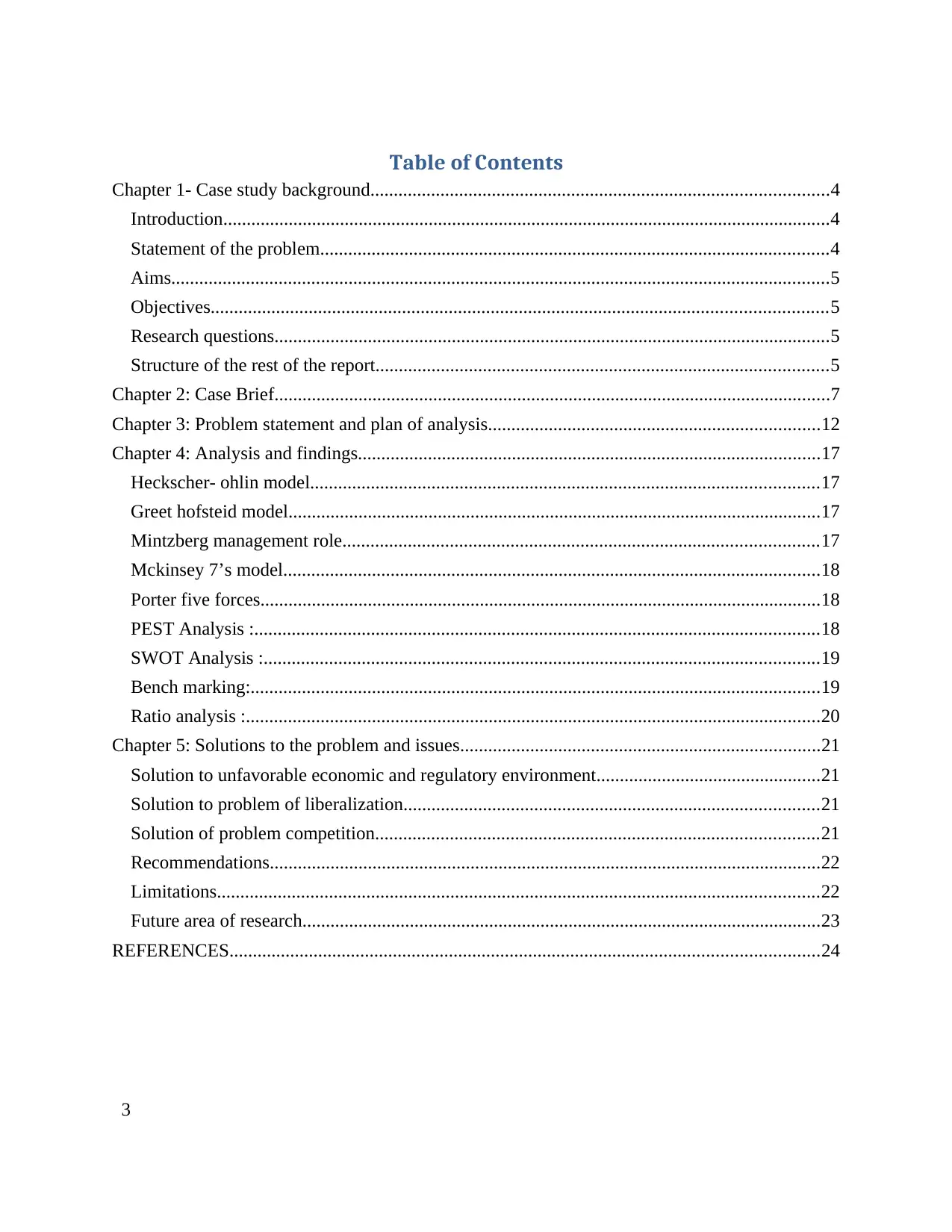
Table of Contents
Chapter 1- Case study background..................................................................................................4
Introduction..................................................................................................................................4
Statement of the problem.............................................................................................................4
Aims.............................................................................................................................................5
Objectives....................................................................................................................................5
Research questions.......................................................................................................................5
Structure of the rest of the report.................................................................................................5
Chapter 2: Case Brief.......................................................................................................................7
Chapter 3: Problem statement and plan of analysis.......................................................................12
Chapter 4: Analysis and findings...................................................................................................17
Heckscher- ohlin model.............................................................................................................17
Greet hofsteid model..................................................................................................................17
Mintzberg management role......................................................................................................17
Mckinsey 7’s model...................................................................................................................18
Porter five forces........................................................................................................................18
PEST Analysis :.........................................................................................................................18
SWOT Analysis :.......................................................................................................................19
Bench marking:..........................................................................................................................19
Ratio analysis :...........................................................................................................................20
Chapter 5: Solutions to the problem and issues.............................................................................21
Solution to unfavorable economic and regulatory environment................................................21
Solution to problem of liberalization.........................................................................................21
Solution of problem competition...............................................................................................21
Recommendations......................................................................................................................22
Limitations.................................................................................................................................22
Future area of research...............................................................................................................23
REFERENCES..............................................................................................................................24
3
Chapter 1- Case study background..................................................................................................4
Introduction..................................................................................................................................4
Statement of the problem.............................................................................................................4
Aims.............................................................................................................................................5
Objectives....................................................................................................................................5
Research questions.......................................................................................................................5
Structure of the rest of the report.................................................................................................5
Chapter 2: Case Brief.......................................................................................................................7
Chapter 3: Problem statement and plan of analysis.......................................................................12
Chapter 4: Analysis and findings...................................................................................................17
Heckscher- ohlin model.............................................................................................................17
Greet hofsteid model..................................................................................................................17
Mintzberg management role......................................................................................................17
Mckinsey 7’s model...................................................................................................................18
Porter five forces........................................................................................................................18
PEST Analysis :.........................................................................................................................18
SWOT Analysis :.......................................................................................................................19
Bench marking:..........................................................................................................................19
Ratio analysis :...........................................................................................................................20
Chapter 5: Solutions to the problem and issues.............................................................................21
Solution to unfavorable economic and regulatory environment................................................21
Solution to problem of liberalization.........................................................................................21
Solution of problem competition...............................................................................................21
Recommendations......................................................................................................................22
Limitations.................................................................................................................................22
Future area of research...............................................................................................................23
REFERENCES..............................................................................................................................24
3
⊘ This is a preview!⊘
Do you want full access?
Subscribe today to unlock all pages.

Trusted by 1+ million students worldwide
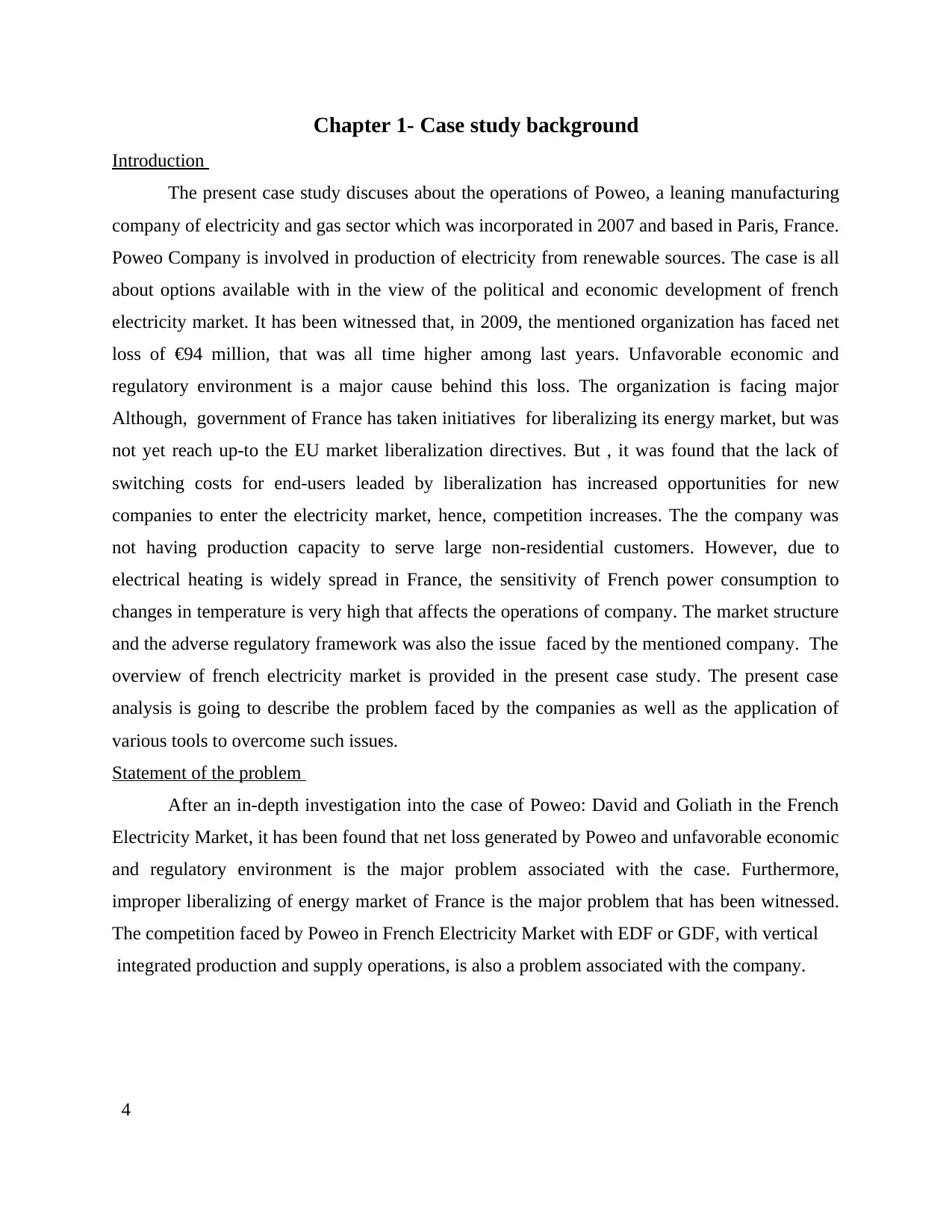
Chapter 1- Case study background
Introduction
The present case study discuses about the operations of Poweo, a leaning manufacturing
company of electricity and gas sector which was incorporated in 2007 and based in Paris, France.
Poweo Company is involved in production of electricity from renewable sources. The case is all
about options available with in the view of the political and economic development of french
electricity market. It has been witnessed that, in 2009, the mentioned organization has faced net
loss of €94 million, that was all time higher among last years. Unfavorable economic and
regulatory environment is a major cause behind this loss. The organization is facing major
Although, government of France has taken initiatives for liberalizing its energy market, but was
not yet reach up-to the EU market liberalization directives. But , it was found that the lack of
switching costs for end-users leaded by liberalization has increased opportunities for new
companies to enter the electricity market, hence, competition increases. The the company was
not having production capacity to serve large non-residential customers. However, due to
electrical heating is widely spread in France, the sensitivity of French power consumption to
changes in temperature is very high that affects the operations of company. The market structure
and the adverse regulatory framework was also the issue faced by the mentioned company. The
overview of french electricity market is provided in the present case study. The present case
analysis is going to describe the problem faced by the companies as well as the application of
various tools to overcome such issues.
Statement of the problem
After an in-depth investigation into the case of Poweo: David and Goliath in the French
Electricity Market, it has been found that net loss generated by Poweo and unfavorable economic
and regulatory environment is the major problem associated with the case. Furthermore,
improper liberalizing of energy market of France is the major problem that has been witnessed.
The competition faced by Poweo in French Electricity Market with EDF or GDF, with vertical
integrated production and supply operations, is also a problem associated with the company.
4
Introduction
The present case study discuses about the operations of Poweo, a leaning manufacturing
company of electricity and gas sector which was incorporated in 2007 and based in Paris, France.
Poweo Company is involved in production of electricity from renewable sources. The case is all
about options available with in the view of the political and economic development of french
electricity market. It has been witnessed that, in 2009, the mentioned organization has faced net
loss of €94 million, that was all time higher among last years. Unfavorable economic and
regulatory environment is a major cause behind this loss. The organization is facing major
Although, government of France has taken initiatives for liberalizing its energy market, but was
not yet reach up-to the EU market liberalization directives. But , it was found that the lack of
switching costs for end-users leaded by liberalization has increased opportunities for new
companies to enter the electricity market, hence, competition increases. The the company was
not having production capacity to serve large non-residential customers. However, due to
electrical heating is widely spread in France, the sensitivity of French power consumption to
changes in temperature is very high that affects the operations of company. The market structure
and the adverse regulatory framework was also the issue faced by the mentioned company. The
overview of french electricity market is provided in the present case study. The present case
analysis is going to describe the problem faced by the companies as well as the application of
various tools to overcome such issues.
Statement of the problem
After an in-depth investigation into the case of Poweo: David and Goliath in the French
Electricity Market, it has been found that net loss generated by Poweo and unfavorable economic
and regulatory environment is the major problem associated with the case. Furthermore,
improper liberalizing of energy market of France is the major problem that has been witnessed.
The competition faced by Poweo in French Electricity Market with EDF or GDF, with vertical
integrated production and supply operations, is also a problem associated with the company.
4
Paraphrase This Document
Need a fresh take? Get an instant paraphrase of this document with our AI Paraphraser
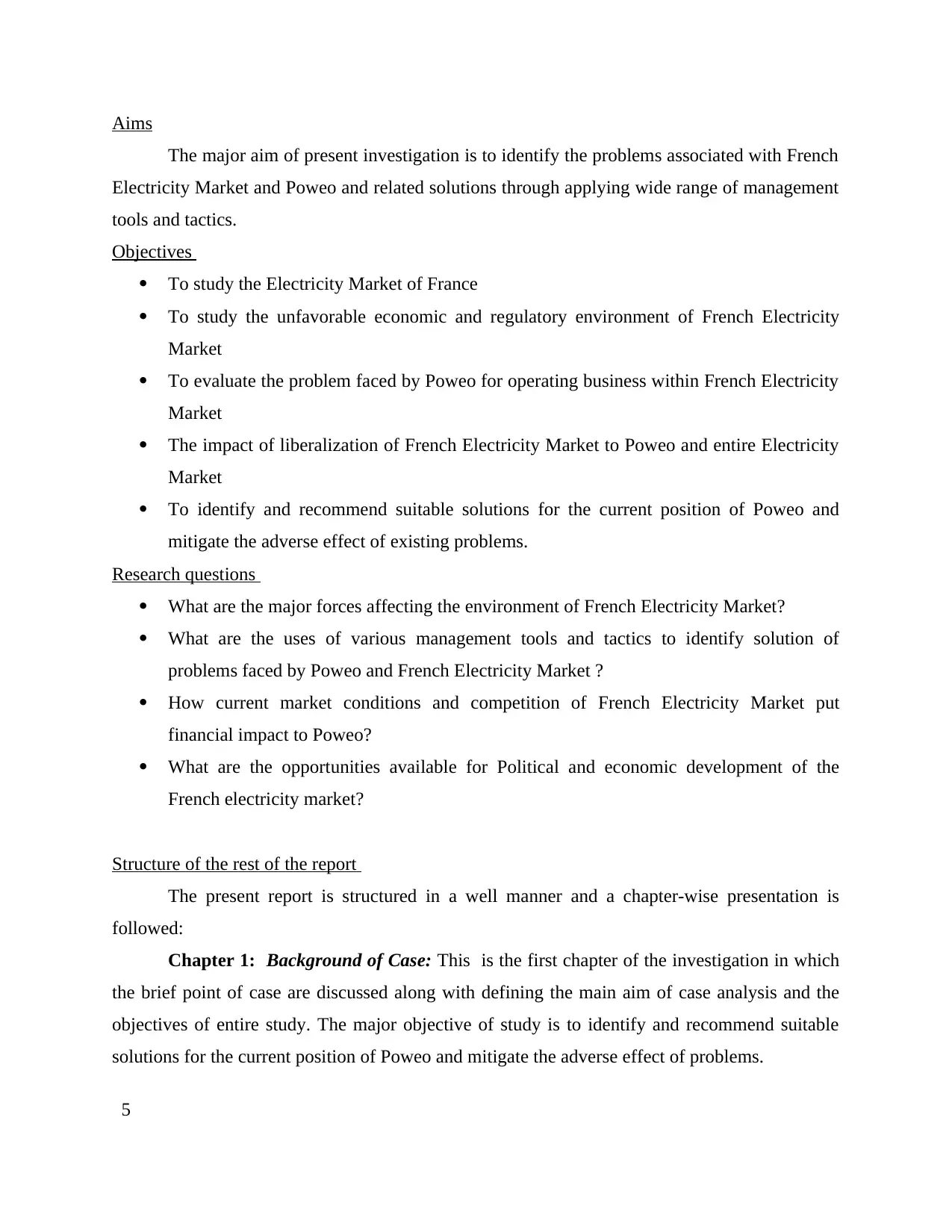
Aims
The major aim of present investigation is to identify the problems associated with French
Electricity Market and Poweo and related solutions through applying wide range of management
tools and tactics.
Objectives
To study the Electricity Market of France
To study the unfavorable economic and regulatory environment of French Electricity
Market
To evaluate the problem faced by Poweo for operating business within French Electricity
Market
The impact of liberalization of French Electricity Market to Poweo and entire Electricity
Market
To identify and recommend suitable solutions for the current position of Poweo and
mitigate the adverse effect of existing problems.
Research questions
What are the major forces affecting the environment of French Electricity Market?
What are the uses of various management tools and tactics to identify solution of
problems faced by Poweo and French Electricity Market ?
How current market conditions and competition of French Electricity Market put
financial impact to Poweo?
What are the opportunities available for Political and economic development of the
French electricity market?
Structure of the rest of the report
The present report is structured in a well manner and a chapter-wise presentation is
followed:
Chapter 1: Background of Case: This is the first chapter of the investigation in which
the brief point of case are discussed along with defining the main aim of case analysis and the
objectives of entire study. The major objective of study is to identify and recommend suitable
solutions for the current position of Poweo and mitigate the adverse effect of problems.
5
The major aim of present investigation is to identify the problems associated with French
Electricity Market and Poweo and related solutions through applying wide range of management
tools and tactics.
Objectives
To study the Electricity Market of France
To study the unfavorable economic and regulatory environment of French Electricity
Market
To evaluate the problem faced by Poweo for operating business within French Electricity
Market
The impact of liberalization of French Electricity Market to Poweo and entire Electricity
Market
To identify and recommend suitable solutions for the current position of Poweo and
mitigate the adverse effect of existing problems.
Research questions
What are the major forces affecting the environment of French Electricity Market?
What are the uses of various management tools and tactics to identify solution of
problems faced by Poweo and French Electricity Market ?
How current market conditions and competition of French Electricity Market put
financial impact to Poweo?
What are the opportunities available for Political and economic development of the
French electricity market?
Structure of the rest of the report
The present report is structured in a well manner and a chapter-wise presentation is
followed:
Chapter 1: Background of Case: This is the first chapter of the investigation in which
the brief point of case are discussed along with defining the main aim of case analysis and the
objectives of entire study. The major objective of study is to identify and recommend suitable
solutions for the current position of Poweo and mitigate the adverse effect of problems.
5
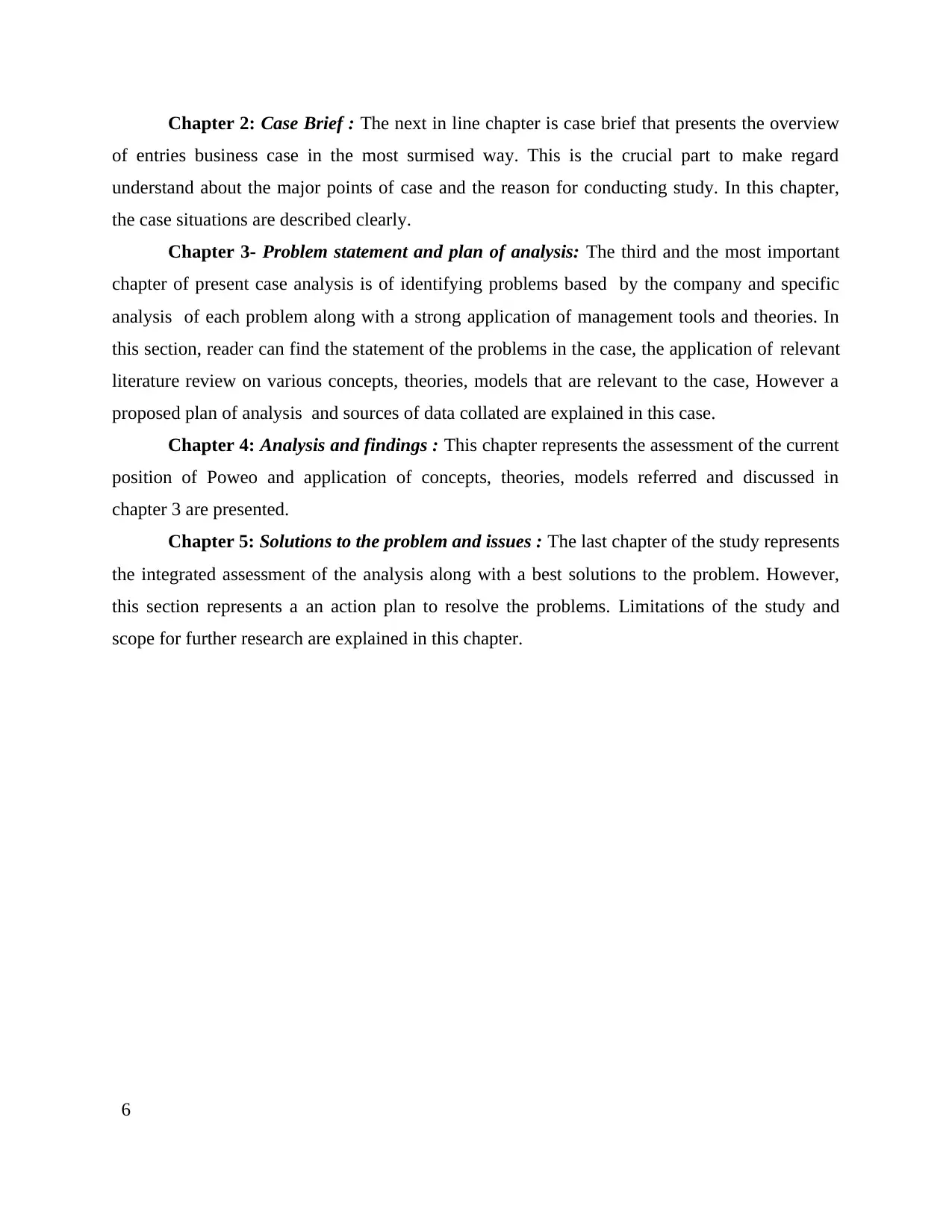
Chapter 2: Case Brief : The next in line chapter is case brief that presents the overview
of entries business case in the most surmised way. This is the crucial part to make regard
understand about the major points of case and the reason for conducting study. In this chapter,
the case situations are described clearly.
Chapter 3- Problem statement and plan of analysis: The third and the most important
chapter of present case analysis is of identifying problems based by the company and specific
analysis of each problem along with a strong application of management tools and theories. In
this section, reader can find the statement of the problems in the case, the application of relevant
literature review on various concepts, theories, models that are relevant to the case, However a
proposed plan of analysis and sources of data collated are explained in this case.
Chapter 4: Analysis and findings : This chapter represents the assessment of the current
position of Poweo and application of concepts, theories, models referred and discussed in
chapter 3 are presented.
Chapter 5: Solutions to the problem and issues : The last chapter of the study represents
the integrated assessment of the analysis along with a best solutions to the problem. However,
this section represents a an action plan to resolve the problems. Limitations of the study and
scope for further research are explained in this chapter.
6
of entries business case in the most surmised way. This is the crucial part to make regard
understand about the major points of case and the reason for conducting study. In this chapter,
the case situations are described clearly.
Chapter 3- Problem statement and plan of analysis: The third and the most important
chapter of present case analysis is of identifying problems based by the company and specific
analysis of each problem along with a strong application of management tools and theories. In
this section, reader can find the statement of the problems in the case, the application of relevant
literature review on various concepts, theories, models that are relevant to the case, However a
proposed plan of analysis and sources of data collated are explained in this case.
Chapter 4: Analysis and findings : This chapter represents the assessment of the current
position of Poweo and application of concepts, theories, models referred and discussed in
chapter 3 are presented.
Chapter 5: Solutions to the problem and issues : The last chapter of the study represents
the integrated assessment of the analysis along with a best solutions to the problem. However,
this section represents a an action plan to resolve the problems. Limitations of the study and
scope for further research are explained in this chapter.
6
⊘ This is a preview!⊘
Do you want full access?
Subscribe today to unlock all pages.

Trusted by 1+ million students worldwide
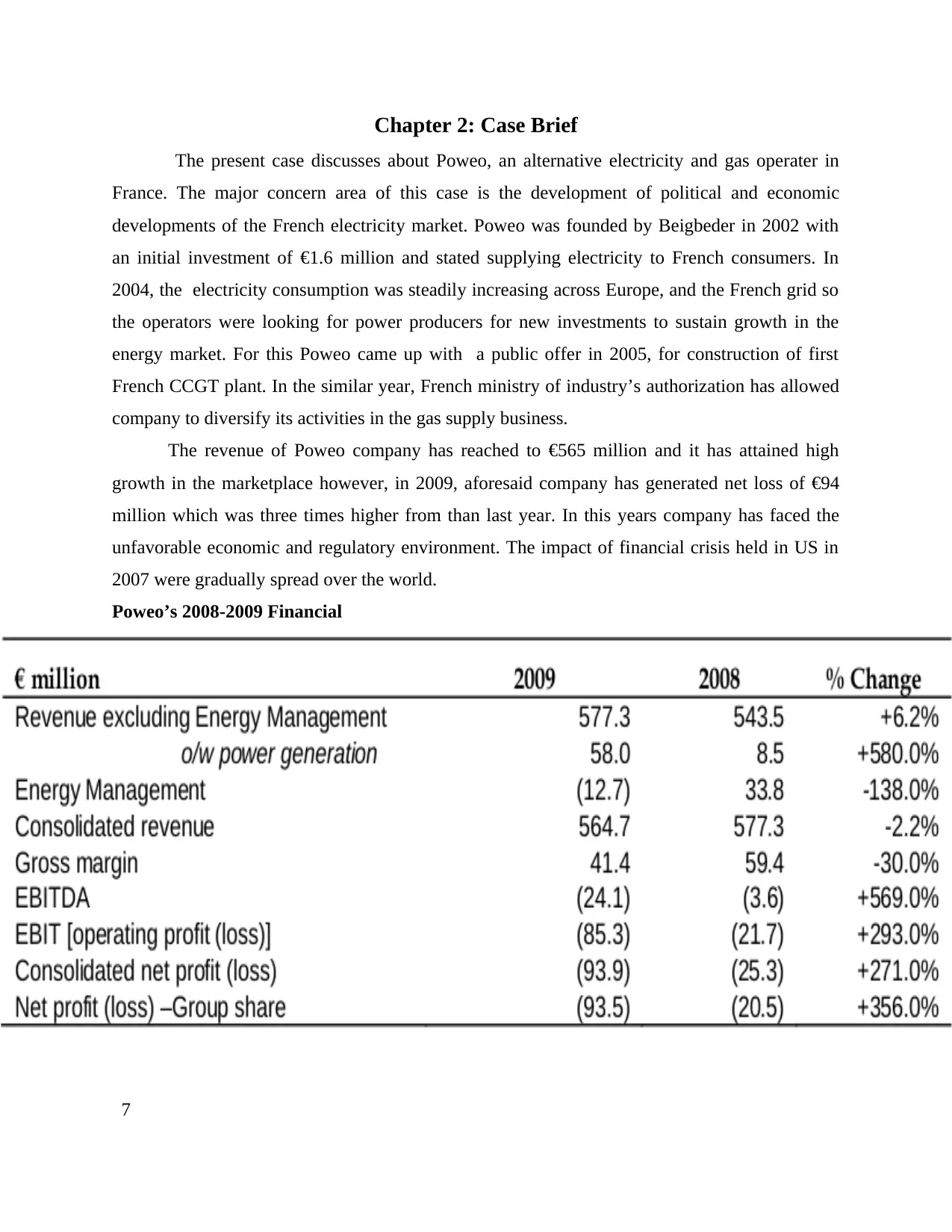
Chapter 2: Case Brief
The present case discusses about Poweo, an alternative electricity and gas operater in
France. The major concern area of this case is the development of political and economic
developments of the French electricity market. Poweo was founded by Beigbeder in 2002 with
an initial investment of €1.6 million and stated supplying electricity to French consumers. In
2004, the electricity consumption was steadily increasing across Europe, and the French grid so
the operators were looking for power producers for new investments to sustain growth in the
energy market. For this Poweo came up with a public offer in 2005, for construction of first
French CCGT plant. In the similar year, French ministry of industry’s authorization has allowed
company to diversify its activities in the gas supply business.
The revenue of Poweo company has reached to €565 million and it has attained high
growth in the marketplace however, in 2009, aforesaid company has generated net loss of €94
million which was three times higher from than last year. In this years company has faced the
unfavorable economic and regulatory environment. The impact of financial crisis held in US in
2007 were gradually spread over the world.
Poweo’s 2008-2009 Financial
7
The present case discusses about Poweo, an alternative electricity and gas operater in
France. The major concern area of this case is the development of political and economic
developments of the French electricity market. Poweo was founded by Beigbeder in 2002 with
an initial investment of €1.6 million and stated supplying electricity to French consumers. In
2004, the electricity consumption was steadily increasing across Europe, and the French grid so
the operators were looking for power producers for new investments to sustain growth in the
energy market. For this Poweo came up with a public offer in 2005, for construction of first
French CCGT plant. In the similar year, French ministry of industry’s authorization has allowed
company to diversify its activities in the gas supply business.
The revenue of Poweo company has reached to €565 million and it has attained high
growth in the marketplace however, in 2009, aforesaid company has generated net loss of €94
million which was three times higher from than last year. In this years company has faced the
unfavorable economic and regulatory environment. The impact of financial crisis held in US in
2007 were gradually spread over the world.
Poweo’s 2008-2009 Financial
7
Paraphrase This Document
Need a fresh take? Get an instant paraphrase of this document with our AI Paraphraser
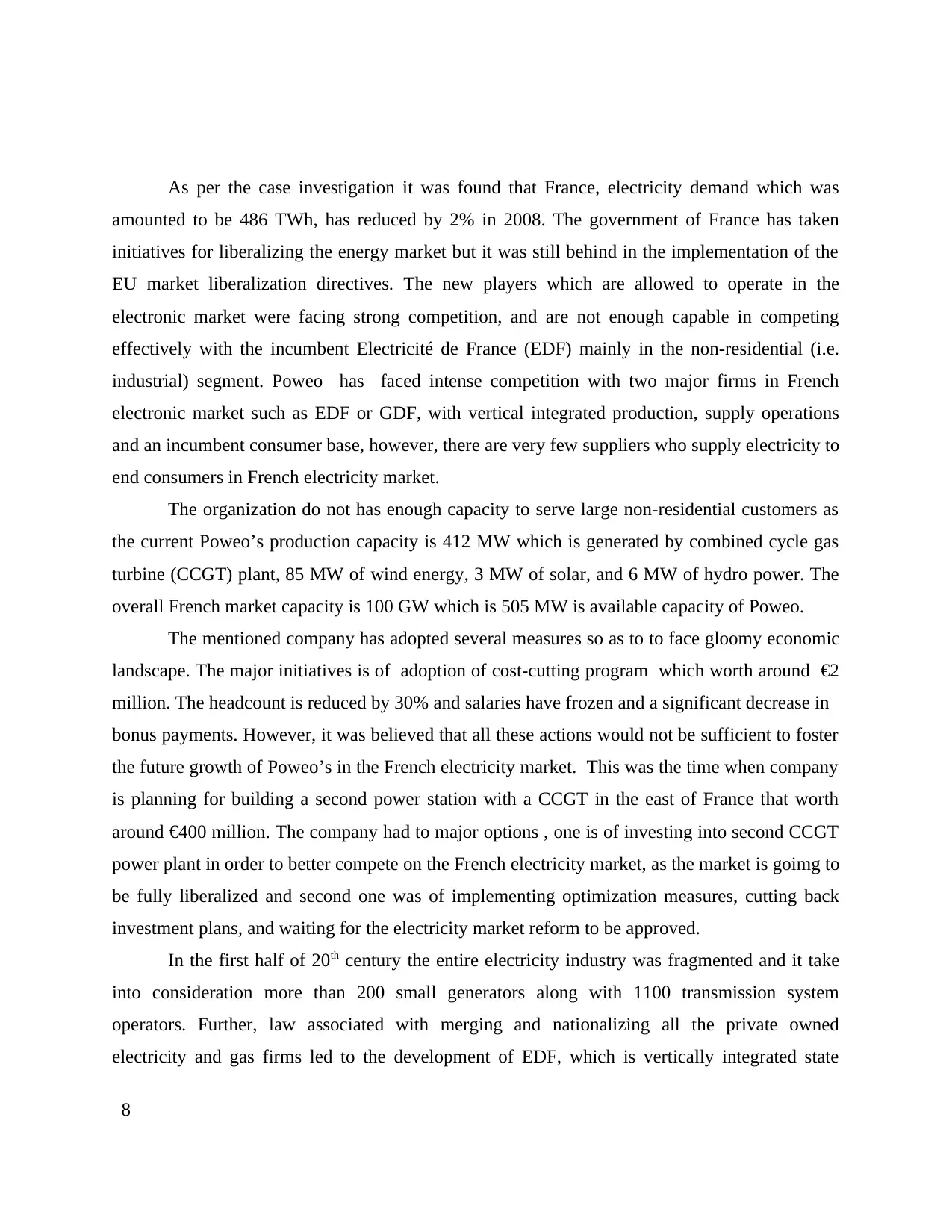
As per the case investigation it was found that France, electricity demand which was
amounted to be 486 TWh, has reduced by 2% in 2008. The government of France has taken
initiatives for liberalizing the energy market but it was still behind in the implementation of the
EU market liberalization directives. The new players which are allowed to operate in the
electronic market were facing strong competition, and are not enough capable in competing
effectively with the incumbent Electricité de France (EDF) mainly in the non-residential (i.e.
industrial) segment. Poweo has faced intense competition with two major firms in French
electronic market such as EDF or GDF, with vertical integrated production, supply operations
and an incumbent consumer base, however, there are very few suppliers who supply electricity to
end consumers in French electricity market.
The organization do not has enough capacity to serve large non-residential customers as
the current Poweo’s production capacity is 412 MW which is generated by combined cycle gas
turbine (CCGT) plant, 85 MW of wind energy, 3 MW of solar, and 6 MW of hydro power. The
overall French market capacity is 100 GW which is 505 MW is available capacity of Poweo.
The mentioned company has adopted several measures so as to to face gloomy economic
landscape. The major initiatives is of adoption of cost-cutting program which worth around €2
million. The headcount is reduced by 30% and salaries have frozen and a significant decrease in
bonus payments. However, it was believed that all these actions would not be sufficient to foster
the future growth of Poweo’s in the French electricity market. This was the time when company
is planning for building a second power station with a CCGT in the east of France that worth
around €400 million. The company had to major options , one is of investing into second CCGT
power plant in order to better compete on the French electricity market, as the market is goimg to
be fully liberalized and second one was of implementing optimization measures, cutting back
investment plans, and waiting for the electricity market reform to be approved.
In the first half of 20th century the entire electricity industry was fragmented and it take
into consideration more than 200 small generators along with 1100 transmission system
operators. Further, law associated with merging and nationalizing all the private owned
electricity and gas firms led to the development of EDF, which is vertically integrated state
8
amounted to be 486 TWh, has reduced by 2% in 2008. The government of France has taken
initiatives for liberalizing the energy market but it was still behind in the implementation of the
EU market liberalization directives. The new players which are allowed to operate in the
electronic market were facing strong competition, and are not enough capable in competing
effectively with the incumbent Electricité de France (EDF) mainly in the non-residential (i.e.
industrial) segment. Poweo has faced intense competition with two major firms in French
electronic market such as EDF or GDF, with vertical integrated production, supply operations
and an incumbent consumer base, however, there are very few suppliers who supply electricity to
end consumers in French electricity market.
The organization do not has enough capacity to serve large non-residential customers as
the current Poweo’s production capacity is 412 MW which is generated by combined cycle gas
turbine (CCGT) plant, 85 MW of wind energy, 3 MW of solar, and 6 MW of hydro power. The
overall French market capacity is 100 GW which is 505 MW is available capacity of Poweo.
The mentioned company has adopted several measures so as to to face gloomy economic
landscape. The major initiatives is of adoption of cost-cutting program which worth around €2
million. The headcount is reduced by 30% and salaries have frozen and a significant decrease in
bonus payments. However, it was believed that all these actions would not be sufficient to foster
the future growth of Poweo’s in the French electricity market. This was the time when company
is planning for building a second power station with a CCGT in the east of France that worth
around €400 million. The company had to major options , one is of investing into second CCGT
power plant in order to better compete on the French electricity market, as the market is goimg to
be fully liberalized and second one was of implementing optimization measures, cutting back
investment plans, and waiting for the electricity market reform to be approved.
In the first half of 20th century the entire electricity industry was fragmented and it take
into consideration more than 200 small generators along with 1100 transmission system
operators. Further, law associated with merging and nationalizing all the private owned
electricity and gas firms led to the development of EDF, which is vertically integrated state
8
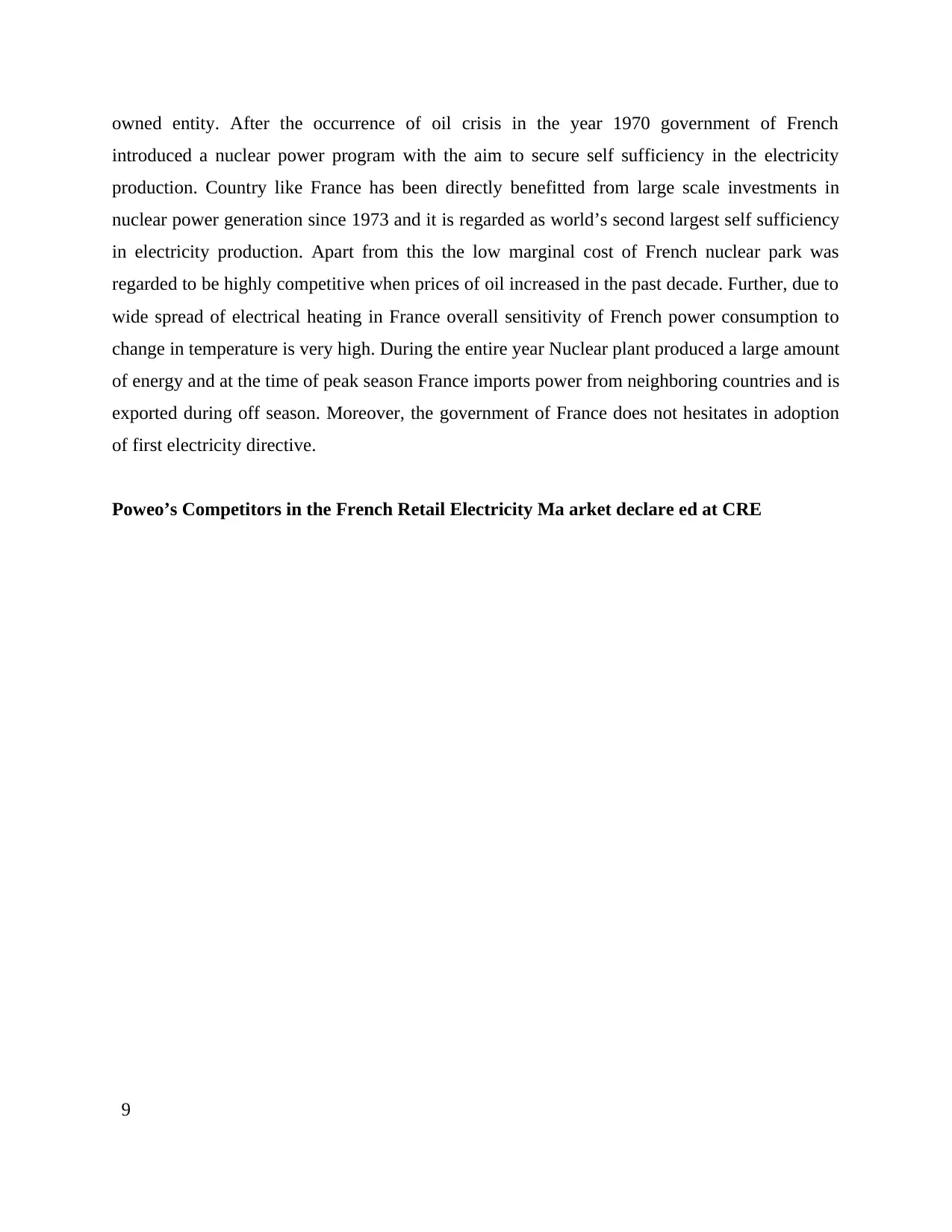
owned entity. After the occurrence of oil crisis in the year 1970 government of French
introduced a nuclear power program with the aim to secure self sufficiency in the electricity
production. Country like France has been directly benefitted from large scale investments in
nuclear power generation since 1973 and it is regarded as world’s second largest self sufficiency
in electricity production. Apart from this the low marginal cost of French nuclear park was
regarded to be highly competitive when prices of oil increased in the past decade. Further, due to
wide spread of electrical heating in France overall sensitivity of French power consumption to
change in temperature is very high. During the entire year Nuclear plant produced a large amount
of energy and at the time of peak season France imports power from neighboring countries and is
exported during off season. Moreover, the government of France does not hesitates in adoption
of first electricity directive.
Poweo’s Competitors in the French Retail Electricity Ma arket declare ed at CRE
9
introduced a nuclear power program with the aim to secure self sufficiency in the electricity
production. Country like France has been directly benefitted from large scale investments in
nuclear power generation since 1973 and it is regarded as world’s second largest self sufficiency
in electricity production. Apart from this the low marginal cost of French nuclear park was
regarded to be highly competitive when prices of oil increased in the past decade. Further, due to
wide spread of electrical heating in France overall sensitivity of French power consumption to
change in temperature is very high. During the entire year Nuclear plant produced a large amount
of energy and at the time of peak season France imports power from neighboring countries and is
exported during off season. Moreover, the government of France does not hesitates in adoption
of first electricity directive.
Poweo’s Competitors in the French Retail Electricity Ma arket declare ed at CRE
9
⊘ This is a preview!⊘
Do you want full access?
Subscribe today to unlock all pages.

Trusted by 1+ million students worldwide
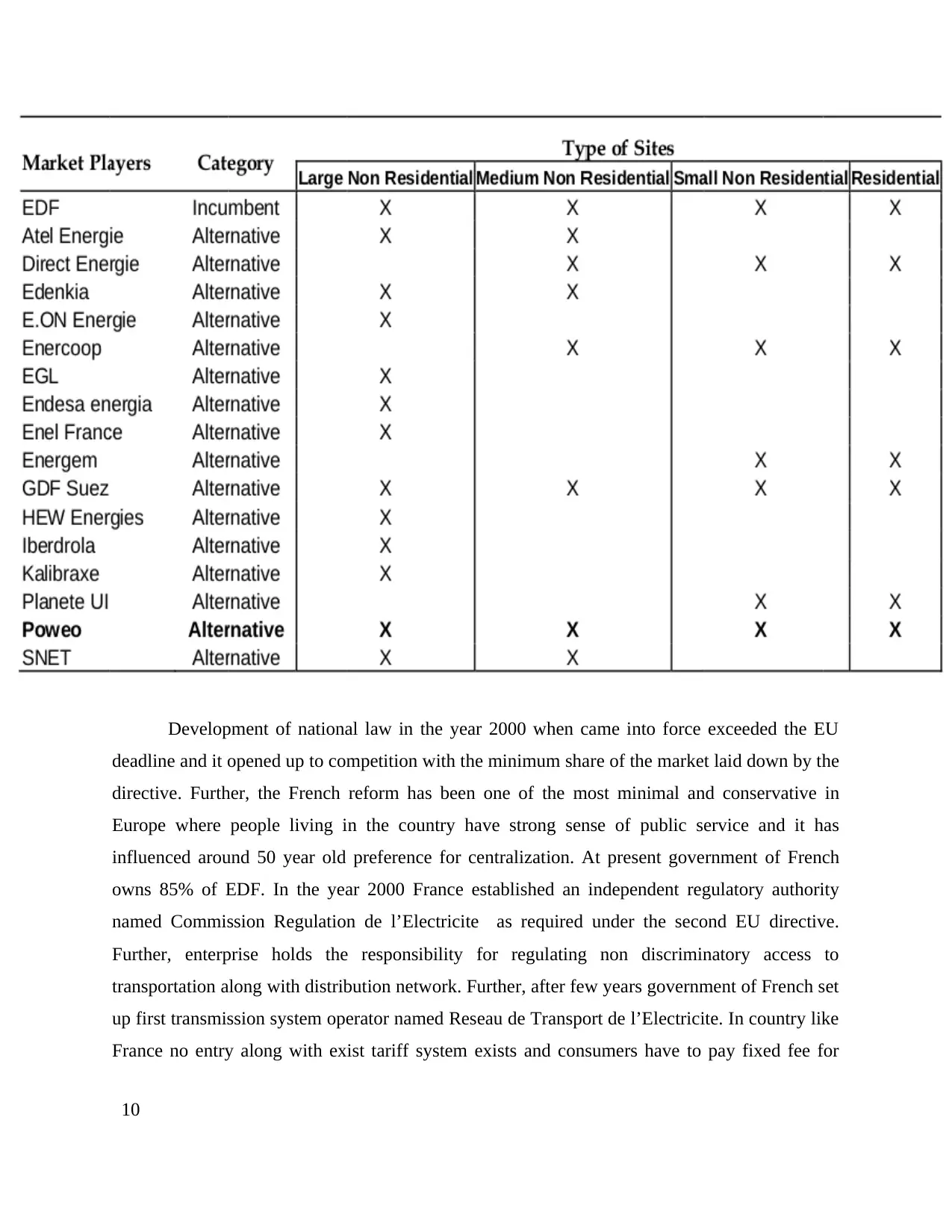
Development of national law in the year 2000 when came into force exceeded the EU
deadline and it opened up to competition with the minimum share of the market laid down by the
directive. Further, the French reform has been one of the most minimal and conservative in
Europe where people living in the country have strong sense of public service and it has
influenced around 50 year old preference for centralization. At present government of French
owns 85% of EDF. In the year 2000 France established an independent regulatory authority
named Commission Regulation de l’Electricite as required under the second EU directive.
Further, enterprise holds the responsibility for regulating non discriminatory access to
transportation along with distribution network. Further, after few years government of French set
up first transmission system operator named Reseau de Transport de l’Electricite. In country like
France no entry along with exist tariff system exists and consumers have to pay fixed fee for
10
deadline and it opened up to competition with the minimum share of the market laid down by the
directive. Further, the French reform has been one of the most minimal and conservative in
Europe where people living in the country have strong sense of public service and it has
influenced around 50 year old preference for centralization. At present government of French
owns 85% of EDF. In the year 2000 France established an independent regulatory authority
named Commission Regulation de l’Electricite as required under the second EU directive.
Further, enterprise holds the responsibility for regulating non discriminatory access to
transportation along with distribution network. Further, after few years government of French set
up first transmission system operator named Reseau de Transport de l’Electricite. In country like
France no entry along with exist tariff system exists and consumers have to pay fixed fee for
10
Paraphrase This Document
Need a fresh take? Get an instant paraphrase of this document with our AI Paraphraser
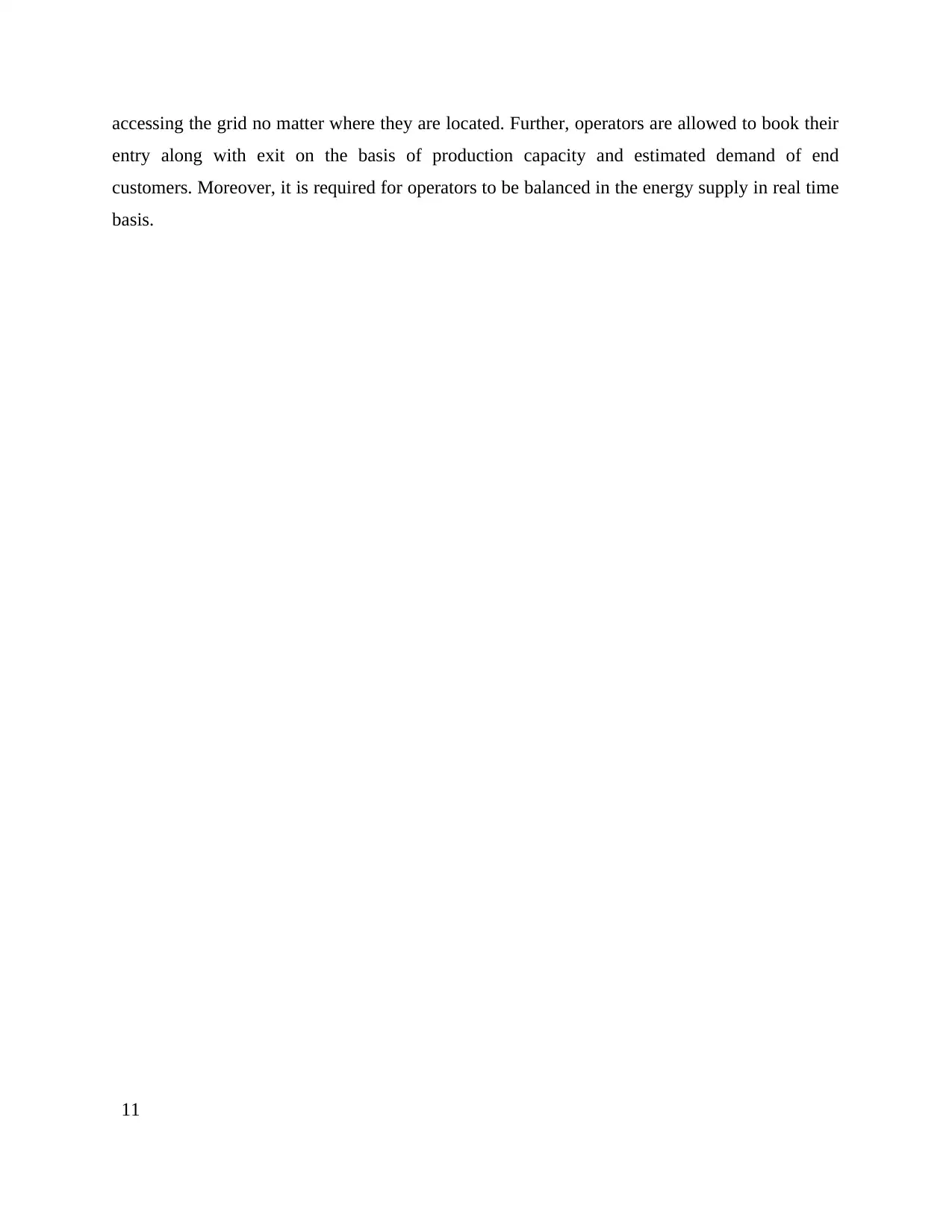
accessing the grid no matter where they are located. Further, operators are allowed to book their
entry along with exit on the basis of production capacity and estimated demand of end
customers. Moreover, it is required for operators to be balanced in the energy supply in real time
basis.
11
entry along with exit on the basis of production capacity and estimated demand of end
customers. Moreover, it is required for operators to be balanced in the energy supply in real time
basis.
11
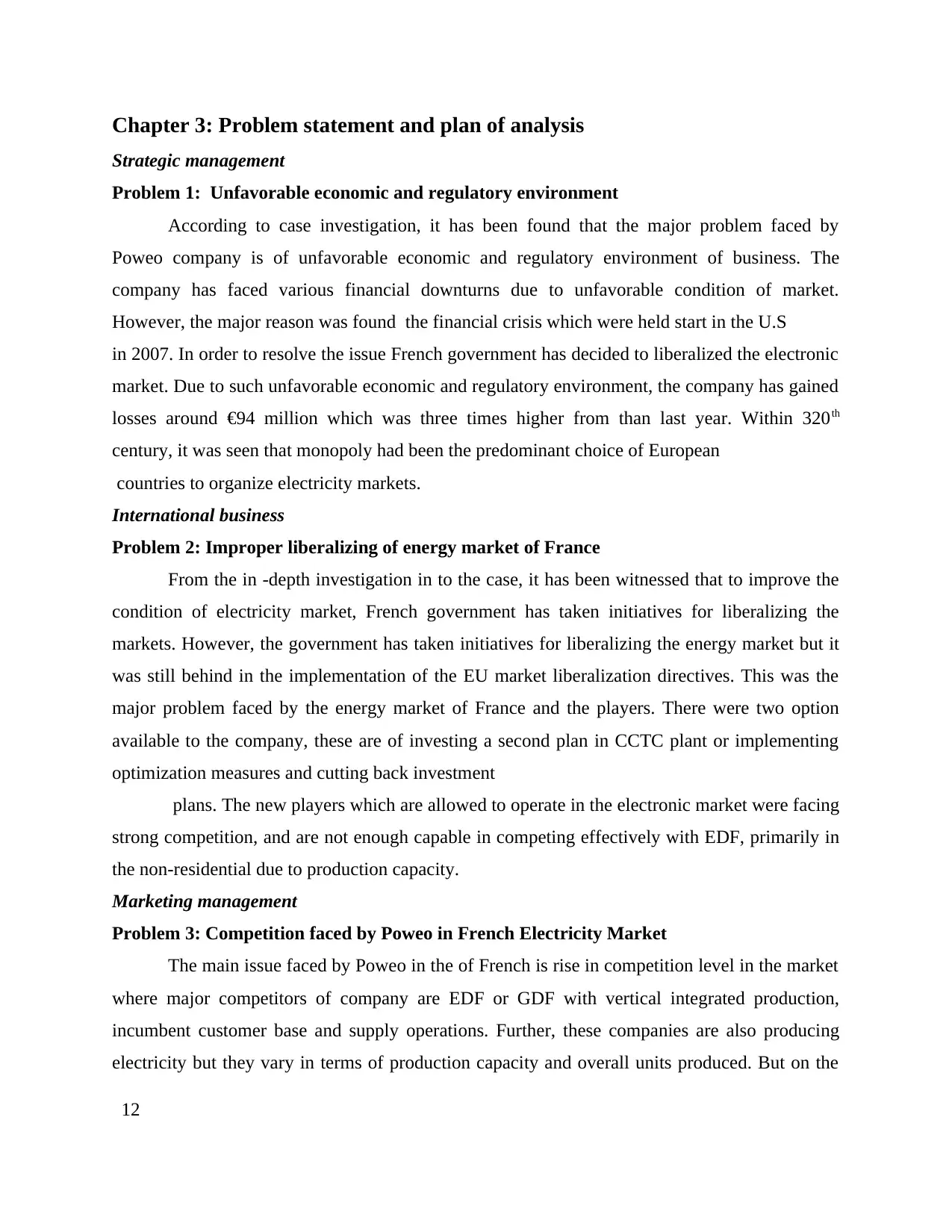
Chapter 3: Problem statement and plan of analysis
Strategic management
Problem 1: Unfavorable economic and regulatory environment
According to case investigation, it has been found that the major problem faced by
Poweo company is of unfavorable economic and regulatory environment of business. The
company has faced various financial downturns due to unfavorable condition of market.
However, the major reason was found the financial crisis which were held start in the U.S
in 2007. In order to resolve the issue French government has decided to liberalized the electronic
market. Due to such unfavorable economic and regulatory environment, the company has gained
losses around €94 million which was three times higher from than last year. Within 320th
century, it was seen that monopoly had been the predominant choice of European
countries to organize electricity markets.
International business
Problem 2: Improper liberalizing of energy market of France
From the in -depth investigation in to the case, it has been witnessed that to improve the
condition of electricity market, French government has taken initiatives for liberalizing the
markets. However, the government has taken initiatives for liberalizing the energy market but it
was still behind in the implementation of the EU market liberalization directives. This was the
major problem faced by the energy market of France and the players. There were two option
available to the company, these are of investing a second plan in CCTC plant or implementing
optimization measures and cutting back investment
plans. The new players which are allowed to operate in the electronic market were facing
strong competition, and are not enough capable in competing effectively with EDF, primarily in
the non-residential due to production capacity.
Marketing management
Problem 3: Competition faced by Poweo in French Electricity Market
The main issue faced by Poweo in the of French is rise in competition level in the market
where major competitors of company are EDF or GDF with vertical integrated production,
incumbent customer base and supply operations. Further, these companies are also producing
electricity but they vary in terms of production capacity and overall units produced. But on the
12
Strategic management
Problem 1: Unfavorable economic and regulatory environment
According to case investigation, it has been found that the major problem faced by
Poweo company is of unfavorable economic and regulatory environment of business. The
company has faced various financial downturns due to unfavorable condition of market.
However, the major reason was found the financial crisis which were held start in the U.S
in 2007. In order to resolve the issue French government has decided to liberalized the electronic
market. Due to such unfavorable economic and regulatory environment, the company has gained
losses around €94 million which was three times higher from than last year. Within 320th
century, it was seen that monopoly had been the predominant choice of European
countries to organize electricity markets.
International business
Problem 2: Improper liberalizing of energy market of France
From the in -depth investigation in to the case, it has been witnessed that to improve the
condition of electricity market, French government has taken initiatives for liberalizing the
markets. However, the government has taken initiatives for liberalizing the energy market but it
was still behind in the implementation of the EU market liberalization directives. This was the
major problem faced by the energy market of France and the players. There were two option
available to the company, these are of investing a second plan in CCTC plant or implementing
optimization measures and cutting back investment
plans. The new players which are allowed to operate in the electronic market were facing
strong competition, and are not enough capable in competing effectively with EDF, primarily in
the non-residential due to production capacity.
Marketing management
Problem 3: Competition faced by Poweo in French Electricity Market
The main issue faced by Poweo in the of French is rise in competition level in the market
where major competitors of company are EDF or GDF with vertical integrated production,
incumbent customer base and supply operations. Further, these companies are also producing
electricity but they vary in terms of production capacity and overall units produced. But on the
12
⊘ This is a preview!⊘
Do you want full access?
Subscribe today to unlock all pages.

Trusted by 1+ million students worldwide
1 out of 24
Related Documents
Your All-in-One AI-Powered Toolkit for Academic Success.
+13062052269
info@desklib.com
Available 24*7 on WhatsApp / Email
![[object Object]](/_next/static/media/star-bottom.7253800d.svg)
Unlock your academic potential
Copyright © 2020–2025 A2Z Services. All Rights Reserved. Developed and managed by ZUCOL.





